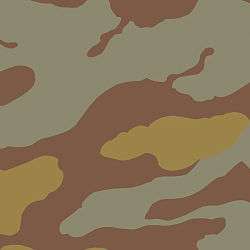Telo mimetico



M1929 Telo mimetico (Italian: camouflage cloth) was a military camouflage pattern used by the Italian Army for shelter-halves (telo tenda) and later for uniforms for much of the 20th century. Being first issued in 1929 and only fully discontinued in the early 1990s, it has the distinction of being the first printed camouflage pattern for general issue, and the camouflage pattern in longest continuous use in the world.[1]
Evolution of the pattern
Originally only printed on shelter halves, the pattern was not intended to be worn by soldiers though the shelter halves could be used as rain-ponchoes. From 1937, the printed fabric was also used for smocks for the Italian paratroopers. At some point before the outbreak of the Second World War, the pattern was changed, possibly to accommodate printing with smaller rolls. It was scaled down and compressed slightly lengthwise, but otherwise kept the shapes and colours of the first production. The pattern varied with time, the colours becoming brighter while the print became less crisp.[1]
Distribution
In 1941, telo mimetico was adopted by the Germans and distributed to Waffen-SS units operating in Italy and Normandy during the spring and summer of 1944. Most frequently published photos show members of the 1st and 12th SS Panzer Divisions wearing the Italian attire along with a mix of standard issue Waffen-SS uniforms and equipment. After the Italian surrender, stocks of the Italian pattern was captured and used on other fronts.[2] Some of it appears to have ended up in the hands of Czechoslovakian and Soviet units.[3] It is possible that the whole production machinery was moved by the Germans to Czechoslovakia, laying the foundation for the country's post-war production.[4]
The pattern was continued into the 1990s, when it was replaced by a pattern based on US Woodland.[5]
Telo Mimetico in art
The pattern also has the honour of having being deemed a work of art in itself. In 1966, the Italian artist Alighiero Boetti stretched sections of the fabric on frames under the title "Mimetico" (camouflage) as part of an exhibition on the Arte Povera movement. It was a challenge to the abstract tachist tradition of painting large, flat sections of colour.[6][7]
References
- 1 2 Verny, Eric; Bocek, Jonathan. "Italian Camouflage". Der Erste Zug. Retrieved 14 September 2016.
- ↑ Borsarello, J.F. (1999). Camouflage uniforms of European and NATO armies : 1945 to the present (1st ed.). Atglen, PA: Schiffer. ISBN 0764310186.
- ↑ Andrew, Stephen; Williamson, Gorden (illus.) (2005). The Waffen-SS (2nd ed.). Oxford: Osprey. ISBN 978-1841765891.
- ↑ "Czechoslovakia". Camopedia.net. Retrieved 9 October 2012.
- ↑ Brayley, Martin J. (2009). Camouflage uniforms : international combat dress 1940-2010. Ramsbury: Crowood. ISBN 1847971377.
- ↑ "Alighiero Boetti, "Mimetico", 1967". Museo Madre. Archived from the original on November 23, 2012. Retrieved 9 October 2012.
- ↑ "Alighiero Boetti: Game Plan. 6th Floor, Special Exhibitions, North. July 01, 2012-October 01, 2012" (PDF). Museum of Modern Art. p. 2. Retrieved 4 June 2015.
External links
- Italian camouflages on Kamouflage.net, showing at least three distinct generations of the pattern, as well as some derivatives.
- Italian camouflages on Camopedia, showing several generations of the pattern.
- The 1966 artwork "Mimetico" among other of Alighiero Boetti's works, also showing the repeats of the fabric.
